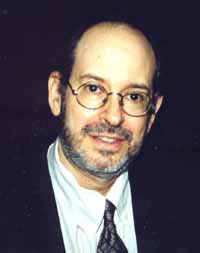Rob Horowitz: Arts Education Promotes Intellectual Development
Rob Horowitz, a TC alum and adjunct Associate Professor of Music Education, describes his profession as doing "research and evaluations of arts partnerships, of what students learn from the arts, and basic research on how the arts affect development and schools." Horowitz, who as Associate Director of Learning In and Through the Arts co-authored a national report on the impact of the arts and learning with Professors Judith Burton and Hal Abeles, talked about the issues he confronts daily.
"There is a debate in the field of arts education whether arts should be taught as instrumental to other subjects, or whether they should be taught for their own sake," Horowitz said.
He said that this dichotomy is a false notion, adding that learning different subjects can contribute to human development. "We would like to find other credible outcomes that we can use to find out what the arts can do rather than rely on high stakes tests. Frankly, schools are under tremendous pressure now and what I see very often is that the arts are pulled back because of pressures on teachers to work on curriculum issues."
Horowitz talked about how his career has changed over the years. "I started out at Teachers College where I received my doctorate in Music Education. I went on to do consulting for arts organizations, schools, school districts, and foundations. I was very involved in setting up the blueprint for the $36 million Annenberg arts education initiative involving 85 schools in New York City. Then I collaborated with professors Burton and Abeles, when we received a grant from the GE Fund and The John D. Catherine T. MacArthur Foundation to look at how the arts affect children."
For their work, Burton, Abeles and Horowitz received the NAEA's 2001 Manuel Barkan Memorial Award for the article based on the report, "Learning In and Through the Arts: The Question of Transfer," which was published in Studies in Arts Education.
The findings were widely distributed by the Arts Education Partnership and the President's Committee on the Arts and Humanities. Burton, Abeles and Horowitz were one of seven groups of researchers around the country. They were all under the umbrella of what was called "Champions of Change." They worked in 29 schools around the country, focusing on 12, trying to understand how the arts impact children and their learning, how they affect teacher practice, and what effect they have on the schools.
"We found various ways," Horowitz said," in which the arts affect school climate, children's relationships with teachers, and more significantly, connections between arts learning and cognitive, social and personal development. We ended up with a model of what that might look like."
"When we worked on 'Champions of Change' we found that looking at reading and math scores are not credible ways to look at an outcome of arts learning," Horowitz said. So we looked at more general capacities or habits of mind; the way kids think, feel about themselves and interact with others. In the cognitive area, we looked at dimensions of creative thinking, such as originality, the idea of coming up with novel solutions to problems."
That was two years ago. Horowitz has been involved in using that work as a basis for evaluating, doing research, and using that model and to see how it applies to other settings. "We're very involved in tracking children's growth into specific cognitive areas," Horowitz said, "like creative thinking abilities, expressive abilities, and in social areas (about how children work together, how they work well with teachers) and personal areas, such as children's self concept, their confidence."
One area that is particularly striking, according to Horowitz, is that children involved in multiple arts activities take risks, they take chances in their learning community. "It takes a lot of courage to do that; to step forward and perform and express themselves."
Another interesting notion Horowitz talked about is "elaboration," which is the ability to think in detail and to go beyond the expected. "In qualitative research, teachers often speak of a child's ability to go beyond a task when he or she is engaged in an arts project."
Horowitz also found that it is through arts experiences and performances that teachers tend to view children in a different light. They see aspects of children that they might not have gotten to understand. That starts to change the relationship, and can change the child's trajectory in school. "Children who are engaged in the arts start to see themselves as good at something else besides the traditional subjects and it gives them a chance to excel in different ways and that can change their relationship with peers."
Today, Horowitz works with a team of researchers and many of them are graduate students from TC. "For instance we've completed four years of qualitative research at a number of schools here in New York City. Recently, we received a grant from the Department of Education for the ArtsConnection -a New York City provider of arts education to New York City schools-to set up artist residencies in various schools. The grant will be used to prepare artists and teachers to work together in the schools and then to try and apply their principals and practices for other schools. I'll be tracking that process but at the same time try to understand this model of learning. We'll begin to see to what degree we can measure it and systematically measure its impact."
Published Sunday, May. 19, 2002
